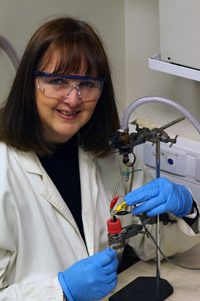 Prof Jeanet Conradie
Photo: Supplied |
Prof Jeanet Conradie, professor in the Department of Chemistry at the University of the Free State (UFS), was the runner up in the senior category for Distinguished Women Researchers: Physical and Engineering Science in the Department of Science and Technology’s 2014 Women in Science Awards. With this award, female scientists and researchers are encouraged and rewarded, and also profiled as role models for younger women.
Science and research, by which new concepts are discovered, is her great passion. Due to this keen interest in science, Prof Conradie studied a variety of subjects during her undergraduate years, providing her with a vast knowledge and the necessary background for her current main research interest, which is a combination of various scientific fields. Her PhD in Chemistry, as well as her strong background in Physics, Computer Science, Mathematics and Applied Maths, influenced her choice of research interest and expertise to gradually develop in the direction of computational chemistry, which is a beautiful combination of chemistry and physics.
Today, Prof Conradie’s research expertise is in computational chemistry, using the super computer and appropriate software to simulate, understand and predict the behaviour of atoms and molecules in real life. The use of computational chemistry makes it possible to study chemical reactions and phenomena that are impossible or too dangerous to study experimentally. Her research team also performs experimental work in the laboratory to combine and compare with the computational analysis. Based on the results obtained, new materials with specific properties are developed.
“We are very proud of Prof Conradie. This award is the result of 14 years of hard word, a lot of it after hours. We are fortunate to have someone like you as colleague who puts guidance to students and learners first in research, teaching and community service,” said Prof André Roodt, Head of the Department of Chemistry at the UFS.
Prof Corli Witthuhn, Vice-Rector: Research said: “Prof Conradie serves as a role model for younger academic scholars in higher education through her motivation, productivity and drive. She also serves as an example of how female scientist can reach the top of their profession while juggling both professional and family responsibilities. This is well deserved recognition for her outstanding research achievements”